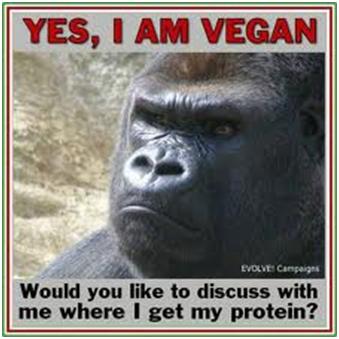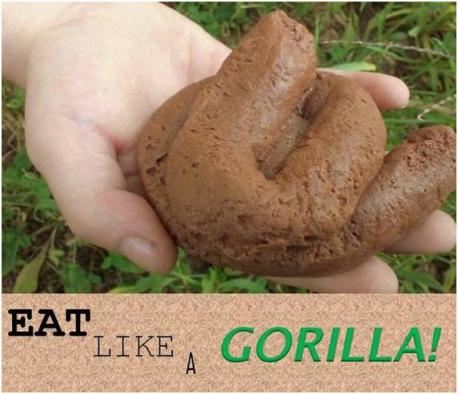Broccoil Protein 6 Oz Beef Compara
Of all the asinine things that I read nearly diet—and let me tell y'all, I read a lot of them—this ane has got to be the asininniest: Broccoli has more than protein than steak.

I've seen this idiotic meme repeated many times, merely the primary source of this stupid—see likewise: delusional, ludicrous, and cool—notion seems to exist Dr. Joel Furhman. My mom—bless her little osteoporotic soul—keeps his books down at the embankment cottage. I don't think she does it to taunt me, but you never know. I was a bad child, and payback may exist in order. My family has forbidden me to read Dr. Furhman's books, to option them up, or to fifty-fifty glance at the covers because the resulting full-on diet-bluster kills everybody'due south beach buzz.
However, as of last week, I have officially maxed out my tolerance for simply ignoring this nonsense. And so, note to my family: Read no further, it will impale your embankment buzz.
According the Dr. Furhman's book, Eat to Live, a 100-calorie portion of sirloin steak has 5.4 grams of protein, and a 100-calorie portion of broccoli has eleven.2 grams of poly peptide. This is rubbish. According to the USDA's Agronomical Enquiry Service's Food Information Laboratory database, 100 calories of broiled beef, top sirloin steak has exactly 11.08 grams of protein and 100 calories of chopped, raw broccoli has exactly 8.29. I'yard not certain what universe Dr. Furhman lives in, just in my universe, 8.29 is less than xi.08.
I can explicate the discrepancy in numbers by the simple fact that Dr. Furhman and I used dissimilar sources for our information. Dr. Furham wrote his book—the ane that contains the piece of drivel nether consideration—in 2005, but he chose to reference a nutrition book written in 1986 (Adams, C. 1986. Handbook of the Nutritional Value of Foods in Common Units, New York: Dover Publications). Just to put things in perspective, in 1986, the net and DVDs had not yet been invented, no one knew who Bart Simpson was, and it would exist another couple of years earlier Taylor Swift even draws her get-go ex-fellow-bashing breath.
Here'due south what I can't explain: Why, oh why did he dig upward a reference nearly two decades erstwhile and not simply use the USDA internet database, which is—and has been since the 1990s—available to anyone with a library card and a half a brain? While I do non wish to speculate on exactly which of these tools Dr. Furhman might be lacking, suffice it to say that information technology would have less than 10 minutes for whatsoever blogger interested in the truth of the matter to detect a more than recent source of information—bold of course that bloggers who perpetuate this particular fiction are interested in the truth.
But await—earlier yous cream at the oral fissure also much, Adele—viii.29 grams of protein is fair flake of poly peptide. At that place is only a difference of a couple of grams of protein between broccoli and steak. Yes, I would agree, those numbers are a lot closer than you might expect, and this might actually exist nutritionally of import, if—Big If—all poly peptide were created equal. Which it isn't.
While I am a big fan of coming at nutrition from an individualized perspective, and I am enlightened that nutrition scientists don't have whatsoever monopoly on truth, we have managed to nail down a few essential things that human must larn from the food that they eat. In terms of essentiality, later on calories and fluid comes protein—or more specifically, essential amino acids (there are more essentials, simply they are not the topic of this detail rant). Because these amino acid requirements are so important (a detail course of starvation, kwashiorkor, involves non overall calorie deprivation, but protein deficit in the context of adequate or near-acceptable calories), the Globe Health Organisation has established specific daily requirements of the essential amino acids that are necessary for wellness.
Let's see how similar caloric intakes of steak and broccoli stack up when comparing how these two foods provide for essential amino acid requirements. A 275-calorie portion of steak (four ounces) has 30.5 grams of protein and comes very close to meeting all the daily essential amino acid requirements for a 70 kg adult. A 277-calorie portion of broccoli is not only way more than food—you'll be chewing for a long fourth dimension equally you endeavour to brand it through ix ¼ cups of broccoli—exactly NONE of the daily essential amino acid requirements for an adult are met:
| EssentialAmino acids (g) | Daily requirement seventy kg developed (g) | Essential amino acids (g) in 275 calories of steak (4 oz or 113.33 thou) | Essential amino acids (g) in 277 calories of chopped, raw broccoli (9.25 cups) |
| histidine | 0.70 | 0.975 ( +0.275) | 0.48 (-0.22) |
| isoleucine | 1.400 | 1.391 (-0.009) | 0.643 (-0.757) |
| leucine | 2.730 | 2.431 (-0.299) | 1.05 (-1.68) |
| lysine | two.100 | 2.583 (+0.483) | ane.099 (-1.001) |
| methionine | 0.seventy | 0.796 (+0.096) | 0.309 (-0.391) |
| cysteine | 0.28 | 0.394 (+ 0.114) | 0.228 (-0.052) |
| threonine | 1.050 | 1.221 (+0.171) | 0.716 (-0.334) |
| tryptophan | 0.280 | 0.201 (-0.079) | 0.269 (-0.011) |
| valine | 1.82 | 1.516 (-0.304) | 1.018 (-0.802) |
In reality, it takes twice that much broccoli, or over 18 cups, containing nearly twice as many calories, in guild to get anywhere near meeting all essential amino acid requirements. While I'm willing to concede that individual amino acid requirements may vary considerably, I am not willing to concede that similar caloric amounts of steak and broccoli provide a like supply of those requirements. I'chiliad no broccoli basher (it's sooo yummy baked with cheese & a footling bacon on tiptop), but as a protein source, fifty-fiftya lot leaves a lot to be desired.
Oh yeah? Well so, "how on world practise animals similar elephants, gorillas and oxen become so big and strong eating only plants? A diverse found-based diet tin can obviously support a big, powerful torso." Sure it can. If you're an elephant or a gorilla or an ox.
In general, human being bodies don't work very efficiently without a regular dietary supply of all essential amino acids: "It would be difficult to find a poly peptide that did not have at least one balance of each of the common 20 amino acids. Half of these amino acids are essential, and if the diet is lacking or low in even ane of these essential amino acids, then protein synthesis is not possible" [Accent mine; reference: Campbell & Farrell'due south Biochemistry, 6th edition]. Protein synthesis allows the states to grow, heal, reproduce, and function in general. 1 of the specific outcomes of protein deficiency in humans is stunting, i.due east. where humans who would otherwise grow bigger, don't.
Dr. Furhman seems to think that those of usa who "believe" that food from animals provides a more biologically complete source of protein than food from plants "never thought too much near how a rhino, hippopotamus, gorilla, giraffe, or elephant became so big eating only vegetables." Hmmm. I have to say, I'm thinking the same thing about Dr. Furhman. Maybe he is unaware that humans aren't actually all that much like rhinoceroses, hippos, gorillas, giraffes, or elephants. But so perhaps he simply hangs out with a different crowd than I do.
Once again, armed with a library card and half a brain, information technology is not likewise difficult to effigy out—assuming y'all did think about how those animals got so big eating but plants and didn't just mindlessly parrot Dr. Furham's poorly-researched blather—that, equally Gomer Pyle would say, surprise! surprise! Humans and other big mammals ARE dissimilar.
While non-ruminants (like humans) must go their essential amino acids from their diet, ruminants (like giraffes) "may also learn substantial amounts of these amino acids through the digestion of microbial protein synthesized in the rumen" (see: Amino Acids in Animate being Nutrition, edited past J.P. Felix D'Mello). This may come as a bit of a shock to Dr. Furhman and his readership, but humans don't actually take rumens and utilizing this item approach to the acquisition of essential amino acids from plant matter ain't gonna work for u.s.a..

You can get enough of poly peptide from a plants-only diet past eating like a hippo.
Other non-ruminant grazers—see elephants, rhinos, and hippos—have a dissimilar eating strategy. They "eat for volume and depression extraction." In other words, the relatively low availability of protein in the food is overcome by the high volume consumed. In that regard—assuming yous aspire to an elephant-like, rhino-like, or hippo-like bod—information technology may exist possible to get sufficient protein from a strictly institute-based diet. If you don't mind eating all the time. And pooping. Less than half of what is consumed by the high-volume grazers is utilized by the body; the rest—like a handsome stranger—is but passin' through (see: Nutritional Ecology of the Ruminant, by Peter J. van Soest). If the idea of literally flushing over half of what y'all swallow down the toilet doesn't bother you, then this strategy actually might piece of work.

ooooh! Can nosotros? Please?
So what about gorillas? This particular primate-to-primate comparison has been tossed all around the cyberspace. Why tin can't we just consume plants like gorillas do? Gorillas, although not so good at Jeopardy, are big and strong and they're vegans, so we should all be vegans likewise, right? Bated from the fact that we don't really know exactly what gorillas are eating much of the fourth dimension, information technology does seem that they eat a lot of bugs along with their plants. So unless yous accept a particularly captious gorilla, some dietary protein won't be vegan. Compared to humans, gorillas also have a much larger proportion of the gut devoted to fermentation—again, another source for microbes to contribute to the nutritional abyss of a plants-only nutrition. And, again, a high volume of nutrient is consumed to compensate for the low nutritional value of it. You won't take to worry about half your food going down the toilet, though. Those who want to live like gorillas tin merely consume that poop instead of flushing it. This provides the torso with another opportunity to excerpt diet from the substance formerly known equally food and may also assistance explain the willingness of Dr. Furhman'due south readers to eat what he's shoveling.

I take nothing against a plants-simply nutrition—in whatever form it takes—if that's what a person want to practise and information technology makes him/her happy. I take no more involvement in converting a vegan to omnivory than I do in having a vegan endeavor to convert me to swearing off bacon. I am besides aware that there is more—much more—to food choices than the nutritional content of the nutrient chosen.
But I'yard agape this is just ane of those situations where ideology has been sent to do the work of science. Ideology has its place, and science has its flaws. Truth, facts, and beliefs can be hard to ascertain and harder still to separate. I become all that. But – to quote Neil deGrasse Tyson – "The good thing most science is that it's true whether or not you believe in it." Unfortunately, for all those gorilla-wannabees out there, the opposite also applies: Assertive in something doesn't make information technology truthful. Y'all can believe all you lot want that broccoli is a better source of protein than steak, simply your ribosomes don't have access to a keyboard and they might vote differently.
Now, honey readers, if yous ever run across some library-card-challenged blogger out in that location perpetuating Dr. Furhman'south little myth, you accept a link to help spill some sunshine on the matter.
Source: https://eathropology.com/2013/04/08/broccoli-has-more-protein-than-steak-and-other-crap/